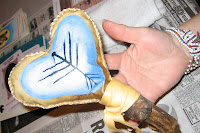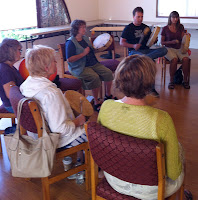Dambrot developed an interest in expository writing and explained that she wants her essays and other writing to be “as engaging as fiction”. When we met at Figaro, a downtown LA eatery and café, Nys Dambrot handed me a catalog that included her recent essay where, in describing Fatemah Burnes’ photographs, she writes:
“They contain ambiguous but accessible
bodies in inhabitable spaces; but amid the hot riot of linear crispness,
mingled layers, and saturated color, these presences are not always easy to
spot straight away, as individuals are both celebrated and subsumed.”
Wording that could easily be part of a fictional story, her
writing conjures up visual imagery that explains the work without seeing the
photographs she describes.
When she completed her BA in Art History from Vassar College
in New York, not knowing what kind of work might be available for someone with
a background in art history, Nys Dambrot asked herself “Is there a job where I
can see and think about art and also write about it?” It all began as a child
growing up in Connecticut and NY, when she visited many museums. A pivotal
moment came when she visited the Museum
of Modern Art where one painting grabbed
her attention. It was by Kazimir Malevich called “White on White” painted in 1919. Nys Dambrot
also talked about a favorite - the Peabody Museum at Yale College, not far from
her home where she often visited a collection of small bird paintings painted by
J. William Gould, coincidentally an ancestor of hers.
When she was a teenager, she saw the Picasso retrospective
which she described as “weird” in that in the show’s totality, she hadn’t seen
such a large collection of cubist work before that time. These childhood
experiences all led her to choose art history as a major course of study in
college. Nys Dambrot described Vassar as the best art history program in the
U.S. where she was mentored by several professors who also brought in many well
known scholars to speak to the students.
Upon graduation from Vassar, Nys Dambrot got a job at the
Guggenheim in N.Y. in their Childrens Education Program. There she helped write
grants for a program that brought professional artists in to teach children.
After a few years in N.Y. C., she visited a friend in Venice California - another
defining moment, that convinced her to move to LA where she quickly got a job
as Gallery Assistant at the Patricia Correia Gallery. That position led her to
meet many art world folks and she began writing
for Juxtapoz, was contributing editor at Artweek Magazine and wrote for others,
and also worked for a collections advisor.
Then in 2002, Nys Dambrot was hired as Managing Editor for Flavorpill,
Los Angleles. Nys Dambrot noted that it was great working for a magazine that "took art seriously" as an important part of American culture along with cultural
events , politics, books and social issues. She was involved in the creation of
400 issues of Flavorpill when she left in 2010.
In more recent years, Nys Dambrot has written a multitude of
catalog essays, been involved in internet TV shows, curating, being on panel
discussions, and has written for a large array of magazines including
Flavorwire, Modern Painters, Art News, Artkrush, Art Ltd.,Art Review, Whitehot,
Coagula, Tema Celeste, VS Magazine, Scene Magazine and others. In discussing
the nuts and bolts of her philosophy about art writing, Nys Dambrot said “ I consider my audience to
be smart people without degrees.” and that she wants to “inject visual culture
into mainstream discourse”. She
commented that she enjoys writing for general culture magazines because she is
achieving her aim of art being included, accessible and easy for the general
public to read and understand. She believes the term “art critic” is misleading
and that she sees herself more as an “art analyst” but admits there is really
no good way to describe what she does in her writing about art.
It is remarkable to hear about the sheer number of art
reviews, editing, writing and other projects she is engaged in – perhaps the
biggest clue to her amazing amount of energy is the “bowl sized” cappuccino
coffee she consumed during our meeting. As we were leaving she told me she was
off to write another 1,500 word essay.










